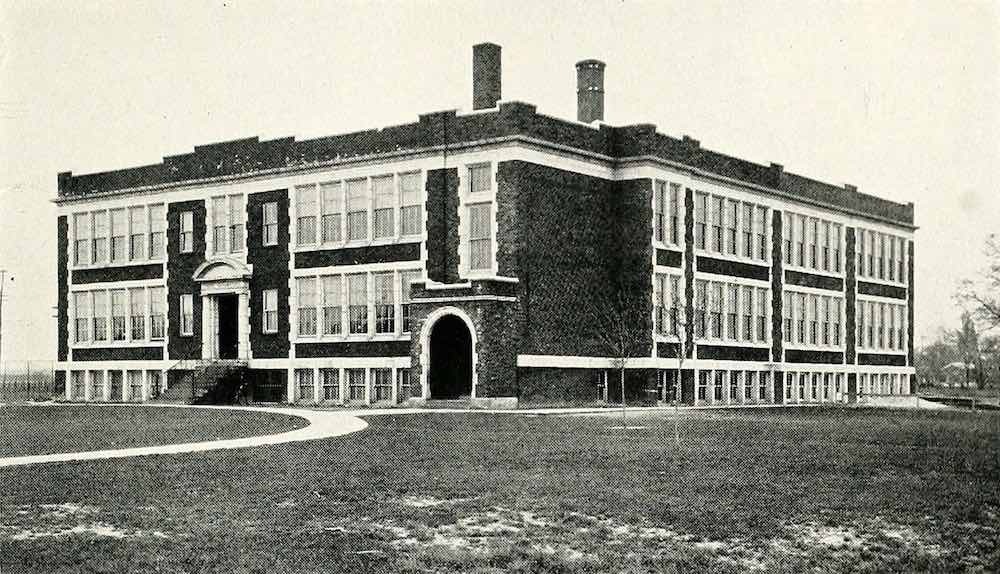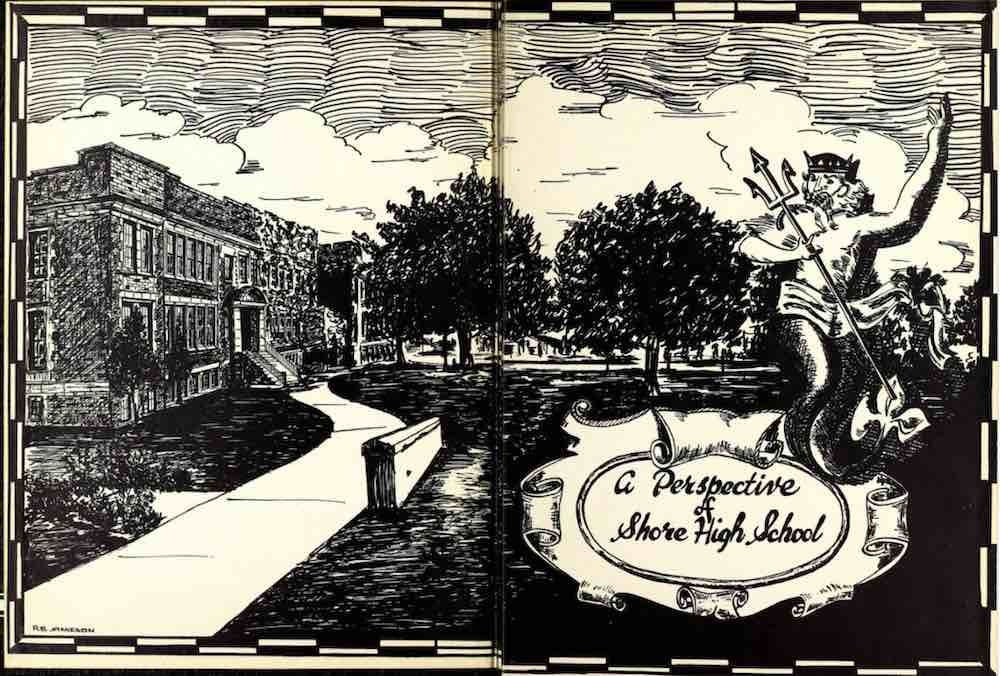Shore High School and Shore Cultural Centre

Euclid is a municipality in Northeast Ohio, founded in 1796 shortly after the survey of the Western Reserve was complete. As part of the contract with Moses Cleaveland, the survey party was allocated a plot of land for them to settle, which they named after the Greek mathematician, Euclid. Euclid had minimal development, becoming more of a wine-making village surrounded by vineyards until the 1930s when industry became more prevalent. Development accelerated after World War II when an influx of veterans came to settle in this now rapidly expanding suburb of Cleveland. Because of this influx of people, schools became much more of a priority. One of them, Euclid-Shore High School, better known as Shore High School, transcended its intended purpose and eventually became a cultural center.
Euclid built Shore in 1912 when it purchased land between Babbitt Road and East 222nd Street. This was considered a very important piece of property near downtown Euclid and is still seen as such. Babbitt Road and East 222nd were being built into central locations, as they both conjoined to Lakeshore Boulevard, and both connected to Euclid Avenue, making Shore’s property very valuable. The three-story school was constructed at a cost of $42,500 and was paired with the other new high school built near Euclid and Chardon Road, Central High School. While Euclid was a small village up to this point, many people were moving from Cleveland proper to the inner-ring suburbs like Euclid. In its early days, Shore was only used as a high school on its topmost floor, having only 22 students in total. With no auditorium built for either school, the graduation ceremonies for both schools were held at City Hall. Shore’s first principal was George E. Honey, who served until 1916. In its early days, the Euclid high schools were much closer to full K-12 schools rather than dedicated high schools.
In 1928, Shore High School was listed in the Directory of Euclid of that same year. It provided information on its public schools, which included Central, by then called Euclid-Central. By this time, Shore and Central enrolled many more high school students, citing at least 615. They also boasted about their accomplishments, specifically noting the strength of their Musical Department, which had many different productions, including “The Spring Maid” and “The Mikado.” They also claimed that Euclid had one of the largest village school systems in Ohio, as Euclid had not yet incorporated as a city. This was the beginning of Shore’s growth into one of Euclid’s largest institutions, showing how far it had come from a simple school of 22 students to 615, not to mention its accomplishments in the arts. To accommodate more students, the school added eight new attachments to the already established building over the next couple of decades. The school had known nothing but growth, so Euclid residents could only imagine more of the same.
Shore’s future became uncertain after World War II. With the suburb’s explosive growth, Euclid High School opened for grades ten to twelve in 1949. Because of this, Shore was converted into a Junior High School housing grades seven to nine. It stayed this way until 1982 when it closed its doors as a school. This was not the end of Shore, however. Even though the onset of population loss in Euclid hurt the municipality, it did not destroy everything that Euclid had built. The old Central High School was demolished in the ’60s, but Shore was spared because of its larger size and potential to become something more.
As already noted, Shore was built on a valuable piece of land, and there were many offers over time by people who wanted to develop on the land. However, the people of Euclid decided to make the building into a community center. The Shore Cultural Centre began its operation in 1985 and, following the school board’s sale of the building to the City of Euclid in 1989, underwent a major renovation. Shore Cultural Centre was an effort done by community leaders who had lived in Euclid for decades. People like Dolly Luskin headed the effort to establish this center. She served on the board for years, serving in many different leadership positions. She believed in its ability to teach future generations about arts and culture while teaching about the city’s past . It preserves the memory of Shore High School and its building is used for cultural activities within the city. The auditorium is the home of the Euclid Symphony Orchestra and many productions. Shore Cultural Centre is a piece of Euclid history, and has been in place for more than a century now. The history of the building is promoted today and has been taught since the 1980s.
This does not mean, however, that there are no controversies with this building. Since 2007, Shore has been under fire by many in the community who claim that the building simply has no use anymore and should be converted into something else. Some believe that the building should be sold to the highest bidder, due to its land value. Others believe it should be converted into a community college. Ideas for what should be done with the building come from all angles, many of which are seen in contentious local city council meetings. The problem, some say, is that Euclid is putting money into something that is not profitable over time, and not necessarily needed. Euclid’s historic preservation project with Shore Cultural Centre has split the community on what is the correct action. Does the city continue to fund the project that could be used differently? Many in Euclid’s government have objected to Shore’s continuing operation because it is an institution that loses more money than it makes through renting out its rooms. There are also issues with the building’s maintenance, Euclid has had difficulties keeping up with infrastructure and has let the building fall into more disarray than it should be. The city has attempted to establish different focus groups on finding what to do with this property, but nothing has come of it yet. Luskin has stated her dismay for the lack of support from the city.
From the time of Shore High School to Shore Cultural Centre, Euclid underwent massive social changes. The 1970s to 2020s have been marked with many changes to the way Euclid functions. Euclid is a majority Black city now, and that cannot be left out of the story when discussing Shore as an institution. White flight had many effects on the local area, one of the most important being the education system. Poverty has been climbing in Euclid, leading to less funding for schools. Shore was kept because of a vision that many Euclid residents had for the future of the city. They believed in preserving the building to teach the future generations about where Shore came from and a promise for a better future.
Euclid’s Shore High School and now Shore Cultural Centre is simply the story of Euclid. It rose from humble beginnings, grew with all the vigor of the suburb whose students it served, and became a cultural landmark. Like Euclid, Shore has seemed to be at the cusp of change in recent years. It holds a mirror to what the transformation of a suburb looks like. From the early days of promise and expansion, Euclid is a case study of what often happens to suburbia over time. Shore, its transformation and uncertain future is one that parallels what Euclid as a whole is currently debating. But more than that, it is now the story of what comes after the fall. Is it to preserve the history and always remember where one’s past lies? Or is it the story of continuous progress, to go beyond what was into what could be?
Images








